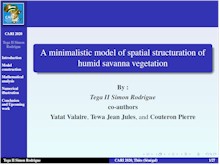
Simon Tega II
A Minimalistic model of spatial structuration of
humid savanna vegetation
Simon Tega II a,*—Valaire Yatatb,c —Jean-Jules Tewab—Pierre Couterond
a Department of Mathematics, University of Yaounde I,
PO Box 812 Yaounde, Cameroon
b National Advanced School of Engineering
University of Yaounde I, Department of Mathematics and Physics
P.O. Box 8390 Yaounde, Cameroon
c Department of Mathematics and Applied Mathematics,
University of Pretoria, Pretoria, South Africa.
d AMAP, IRD, CIRAD, INRA,
Université de Montpellier, France,
ABSTRACT. In this work, we propose a spatio-temporal tree-grass interactions model, allowing to account for a possibly periodic spatial structuring sometimes observes in humid savanna zone. The proposed model relies on an integro-differential reaction-diffusion system, involving kernels of intra and inter-specific interactions. From a linear stability analysis performed in the vicinity of a homogeneous stationary state that denotes tree-grass coexistence, we succeed first to find a condition for the appearance of periodic solutions in space with predictable wavelength and second, to illustrate it numerically.
RÉSUMÉ. Dans ce travail, nous proposons un modèle spatio-temporel d’interactions arbres-herbes, permettant de rendre compte d’une structuration spatiale éventuellement périodique parfois observée en zone de savane humide. Le modèle proposé repose sur un système de réaction-diffusion intégrodifférentiel, impliquant des noyaux d’interactions spatiales intra et inter spécifique. A partir d’une analyse de stabilité linéaire realisée au voisinage d’un état stationnaire de coexistence, nous réussissons premièrement, à trouver une condition pour l’apparition de solutions périodiques en espace avec une longueur d’onde prévisible et deuxièmement, nous illustrons cette condition numériquement.
KEYWORDS : Tree, Grass, Non local interaction, fire, Turing Bifurcation.
MOTS-CLÉS : Arbre, Herbe, Interactions non locales, feu, Bifurcation de Turing.



